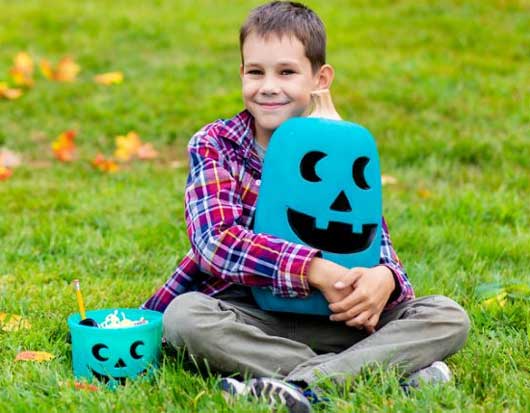
Please choose a body region on the right for you to pin point the problem area of your body.

Shop by Condition

Shop by Brand
Along with traditional orange pumpkins, you may see some other colors decorating people’s houses or while out trick-or-treating this Halloween.
But it’s not because people are trying to mix things up by forgoing the usual orange variety. Halloween can be a tricky time for kids with food allergies (many candies contain allergens, such as nuts, which can be life-threatening), as well as children on the autism spectrum (who may get overwhelmed or be nonverbal). So some parents are displaying teal pumpkins for food allergy awareness or using blue Halloween buckets for trick-or-treating, which have become the unofficial symbol for autism awareness.

Teal pumpkins placed in front of a house mean there are non-food treats for kids with food allergies, which allows them to safely participate in Halloween. “ The Teal Pumpkin Project was started by Becky Basalone, a food allergy mom from Tennessee, in 2012 as a grassroots effort,” Lisa Gable, chief executive officer of FARE (Food Allergy Research & Education), tells Yahoo Lifestyle. “FARE took it to the national stage in 2014 to raise awareness of food allergies and create a safer, more inclusive Halloween for all trick-or-treaters.”
By placing a teal pumpkin on your doorstep, you are letting trick-or-treaters with food allergies and their families know that your house is food-allergy friendly, notes Gable. “This means offering non-food treats in addition to more traditional Halloween candy, making the holiday inclusive for all children who want to celebrate,” she says.
For families who want to participate in the Teal Pumpkin Project, they can register their home so kids with food allergies know where to safely trick-or-trick. Gable recommends keeping non-food treats in a separate bowl, away from any candy you might be handing out on Halloween. For non-food treats ideas, FARE recommends giving out glow sticks, bracelets, or necklaces; pencils, pens, crayons, or markers; bubbles; Halloween erasers or pencil toppers; mini slinkies; whistles, kazoos, or noisemakers; bouncy balls; finger puppets or novelty toys; mini notepads; or playing cards. The items can be found at dollar stores, party supply stores, or online shops.
“There are a few important things to remember about giving out certain non-food treats and trinkets,” says Gable. “Namely, some non-food items still contain food allergens, like some brands of moldable clay, which can contain wheat. Also, if you can, try to choose latex-free items, as latex allergies are also prominent.”
Blue Halloween buckets are a subtle way to indicate that the child going trick-or-treating has autism. It appears to have started with Alicia Plumer, a mom whose 21-year-old son BJ has the condition. Plumer’s Facebook post about her son using a blue Halloween bucket to raise awareness of autism went viral in 2018 with 28,000 shares. “While he has the body of a 21 year old, he loves Halloween,” Plumer wrote. “These precious people are not ‘too big’ to trick or treat.”
That may have inspired Omairis Taylor, mom of a 3-year-old with autism, to do the same. On Oct. 16, the mom posted on Facebook about why her child, who is nonverbal, will be carrying a blue Halloween bucket this year. “Last year houses will wait for him to say TRICK OR TREAT in order for him to get a piece of candy and there I go explaining the situation for the next 5 blocks,” Taylor wrote in her viral post, which has 152,000 shares. “This year we will be trying the BLUE BUCKET to signify he has autism.”
Taylor added: “Please allow him (or anyone with a BLUE BUCKET) to enjoy this day and don't worry I'll still say TRICK OR TREAT for him, [I’ll] get my mom candy tax late.”
Wendy Fournier, president of the National Autism Association , tells Yahoo Lifestyle that blue Halloween buckets could make the holiday easier for children with autism and provide a “dignified way” of letting people know that a child or young adult may not be able to participate in all of the traditional aspects of trick-or-treating. “We believe it could be helpful, especially for the more severely affected kids who are non-verbal and for older kids who function at a lower cognitive age level,” Fournier says. “Some kids can't say, ‘trick or treat’ or ‘thank you.’ They may not be able to make eye contact, and could also have sensory issues that prevent them from wearing a mask. So for some individuals with autism, there are a lot of challenges to overcome on Halloween, but they just want to have fun like everyone else.”
| Stay Connected! | |
|
|
|
Related Articles
Get $10 off your next order when you sign up to receive our email newsletter.*
Simply enter your email address below!
*Minimum order value of $100. Valid email address to qualify.







